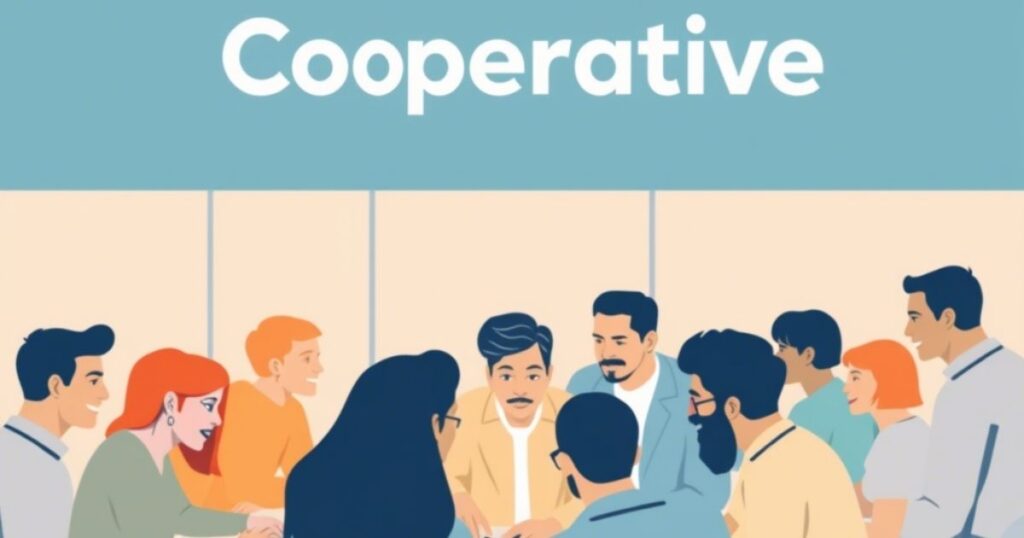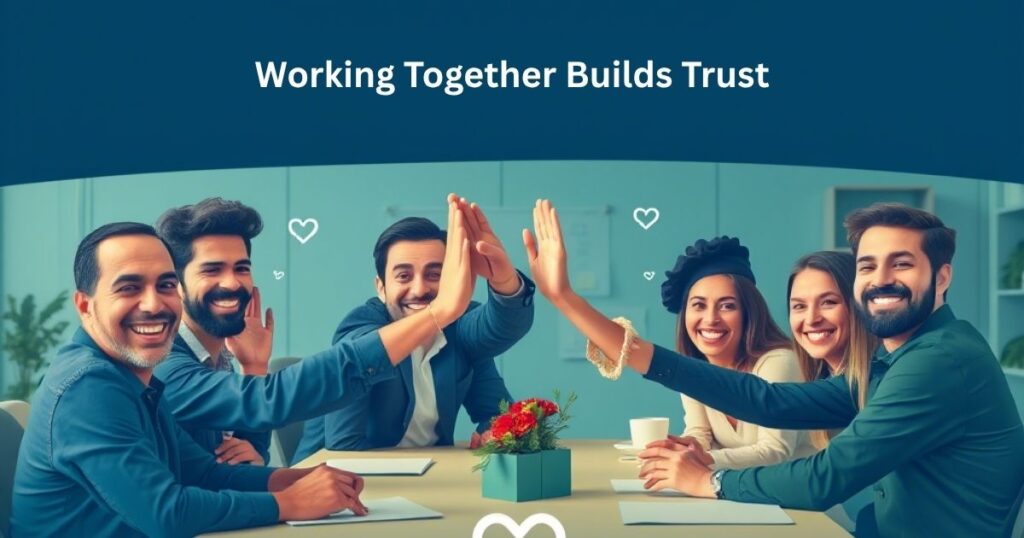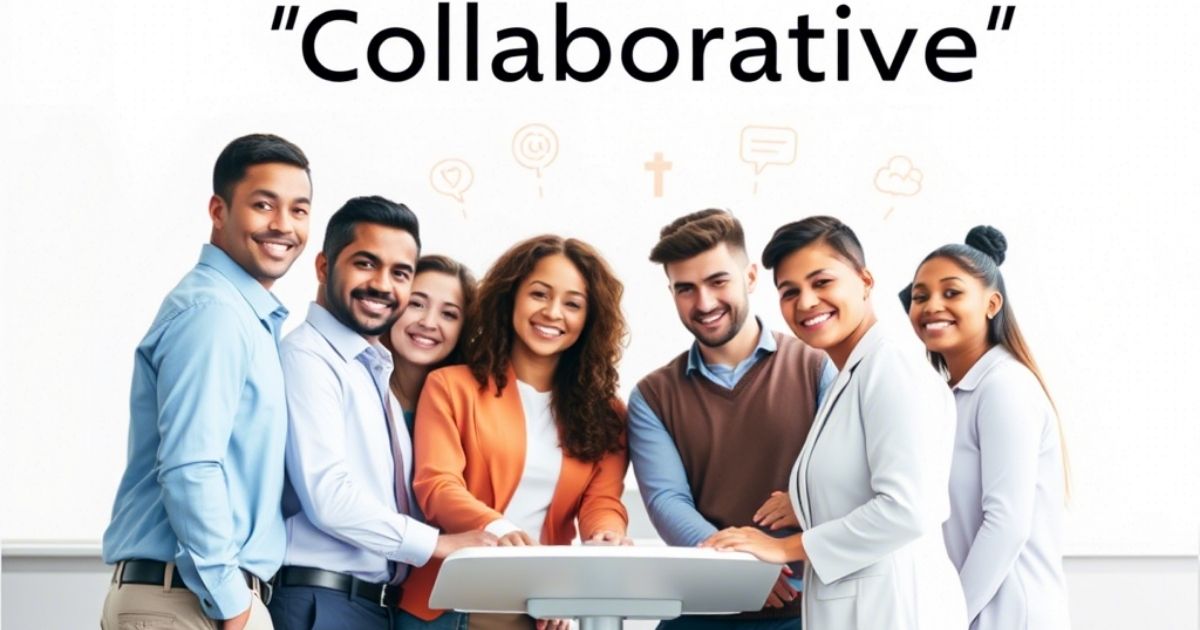In today’s fast-paced and team-driven world, communication is key,and so is using the right words to describe how we work together. Whether you’re in a business meeting, writing a report, or managing a project, using the word collaborative correctly can help you convey unity, teamwork, and shared effort. But repeating the same term can sound repetitive or flat, especially in professional or creative writing. That’s why knowing different ways to say collaborative gives you a stronger, more polished voice.
From formal settings to casual discussions, having a range of expressions helps you sound clear, engaging, and versatile. Words like cooperative, joint, and synergistic not only replace collaborative, but also add subtle differences in meaning that make your communication more precise. In this article, we’ll walk through the best alternative terms to use instead of collaborative,each packed with context, clarity, and purpose for readers in every industry.
Main Points
In everyday communication, using the same word again and again can get boring. One such word is collaborative. It is a great word that shows people working together. But sometimes, we want to use different words with the same or similar meaning. That’s where learning another word for collaboration helps. These words can make your writing and speech clearer, more interesting, and more human. When you work in education, business, or even on community projects, using the right words like cooperative, joint, or synergistic helps you explain things better. They give more meaning and fit different situations well.
Each word we are going to learn today brings a small new meaning. Some talk about shared goals, some show mutual effort, and others speak of group creativity or strategic partnership. In this blog, you’ll find easy words and ideas to help you talk about teamwork, responsibility, and working together. Let’s begin.
- People learn better when they work together.
- Sharing ideas helps everyone think smarter.
- Each person has something special to offer.
- Helping others makes the group strong.
- Listening is just as important as speaking.
- Trust grows when people work as one.
- Different views bring new and better answers.
- Working in a group teaches real-life skills.
- Talking clearly helps stop problems.
Cooperative

Cooperative means people or groups helping each other to reach the same goal. In education, students often do cooperative learning by sharing ideas and helping one another understand better. This improves creativity, understanding, and builds responsibility. Everyone plays a part, and no one is left behind.
In the business world, cooperative tasks involve working as a team to complete projects. This builds trust and improves how well a team works together. When everyone shares the tasks, they feel valued. Cooperative teamwork creates better results because people bring different skills and perspectives. It’s a simple but strong word that shows people are working together for success.
Introduction to Collaborative Learning
Collaborative learning means learning together. It is when people work as a group to solve a problem or finish a task. This method helps everyone learn better and share their perspectives. Whether in schools, colleges, or business places, collaborative learning is a strong tool. It helps people improve their communication, build teamwork, and grow their creativity. It also brings different ideas together and makes the group stronger.
When students or workers learn as a team, they feel a sense of belonging. They feel their contribution matters. This feeling helps them do better. It increases productivity, and they become more open to learning new things. Learning together means they share responsibility, support each other, and work toward a common goal. Each person brings their own strengths to the team. This helps the team grow and come up with better solutions.
The Importance of Group Work in Education
Group work is very important in education. When students work together, they learn new ways of thinking. They understand how to listen to others and respect different perspectives. This is very helpful because the world is full of diverse people. In group learning, each student gets to use their skills and also learn from others. This makes learning more interactive, fun, and deep.
When students are given a task, they must talk, share, and plan as a team. This team-oriented way helps them improve their communication and problem-solving skills. They start to care about each other’s success. This builds cohesion and unity in the class. Teachers also play a big role. They guide the group, keep it focused, and help every member take part. The shared responsibility helps students understand how real-life teamwork works, like in business or community projects.
Joint
Joint means two or more people or groups coming together to do something with shared goals. It often describes joint ventures in business, where companies work as a team. They combine resources, expertise, and strategies to reach a common objective. This teamwork improves efficiency and helps solve problems faster.
In everyday life, you might hear about joint decisions or joint efforts. This shows that everyone had a part to play. Whether it’s a school group project or a large company deal, joint efforts show equal participation, strong communication, and a clear shared purpose. It’s a strong collaboration syn that works well in formal and informal settings.
Collective

Collective shows a group working as one. It means many people are combining their strengths, ideas, and resources to reach one goal. In education, collective learning helps students learn from each other’s experiences, giving them different perspectives and improving understanding.
In the workplace, collective decision-making makes sure everyone’s voice is heard. It builds trust and a sense of ownership. Each member shares the responsibility for the outcome. This makes the group stronger and more creative. Using collective instead of collaborative gives your message a more united and people-focused feeling.
Read this Also: 13 Other Ways to Say “I Am Interested In This Position”
Team-oriented
Team-oriented describes people who think and act for the whole team, not just themselves. It’s about working toward shared goals with strong team dynamics, open communication, and a clear vision. This kind of teamwork is often used in business and education to improve productivity and creativity.
A team-oriented environment values every person’s role. People feel they belong and that their contributions matter. This builds better relationships, encourages dialogue, and helps solve problems together. When people work in a team-oriented way, they grow both as individuals and as part of the group.
Synergistic
Synergistic is a fancy word, but it has a simple meaning. It means when people work together, the result is better than what they could do alone. This is called synergy. In collaborative tasks, synergy helps increase creativity, innovation, and productivity by using everyone’s strengths.
A synergistic approach allows freedom of ideas. Each person adds something special. The final outcome becomes a mix of all those ideas, and it works better. Synergistic communication builds stronger relationships, and the team can achieve big things together. It’s one of the best words to use instead of collaborative when you want to show powerful teamwork.
Find more words!
You might want to say collaborative, but the same word gets boring fast. So, it’s helpful to use many words like collective, joint, or cooperative. These add style and clarity to your writing or speech.
When you’re writing about teamwork in school, business, or life, using a collaboration syn gives more color to your ideas. Just like using new tools, these words help you say the same thing but in a fresh and better way. So, instead of just one word, you now have many to show shared efforts, participation, and group success.
Unified
Unified means people are working as one, with the same purpose and vision. In a unified team, every person is heading in the same direction. This builds trust, improves communication, and brings better results. Whether it’s in school or a big company, being unified helps people feel like they’re part of something important.
A unified approach to problem-solving also helps in complex projects. When everyone is on the same page, ideas move quickly, and there’s less confusion. Unified teams also handle stress better because they feel supported. It’s a great word to replace collaborative when you want to show teamwork with strong togetherness.
Partnership-driven
Partnership-driven means the team depends on strong partnerships. Each member brings their own skills, and they trust each other. This kind of collaborative work improves innovation, efficiency, and goal alignment.
Partnership-driven teams often work on long-term ventures. They share resources, face problems together, and win together. This makes them stronger over time. If you’re writing about teamwork with shared commitment, this is a perfect synonym for collaborative.
Coactive

Coactive is a cool word that means people work at the same time and help each other directly. They are not just working side by side; they are sharing tasks, ideas, and efforts in real time.
This kind of work builds accountability, improves engagement, and helps solve problems fast. Coactive teams know what others are doing and support them at every step. In education or business, using coactive strategies can make teamwork more smooth and powerful. It’s a great alternative when you want to say collaborative but with more action and flow.
Integrative
Integrative means combining different parts or perspectives into one strong group. In teamwork, an integrative approach brings together people with different skills, views, and strengths. The result is more complete and creative.
Whether it’s in learning, solving problems, or doing a project, an integrative team listens to everyone. They blend ideas and make sure every voice counts. This helps build understanding, improves communication, and gives better results. It’s a great way to say collaborative when you want to show deep, thoughtful teamwork.
Contributive
Contributive focuses on what each person brings to the team. Every contribution matters. Whether it’s a new idea, a solution, or just doing your part, it’s all important.
This model works well in the workplace, where each person’s input improves the project. It also builds confidence and shows that teamwork needs every voice. Using contributive instead of collaborative helps you point out the value of each person in the group.
Communal
Communal means doing things together as a community. People share responsibilities, resources, and even experiences. In communal living or work, everyone supports each other. There’s a strong sense of unity and shared purpose.
This word is great when you want to talk about group work that feels more like a family or community. It’s another word for collaborative that adds warmth and connection.
Allied
Allied means people or groups have joined together to support each other. In a way, it’s like forming a partnership or a team. They may have different roles, but their goals are the same.
Allied collaboration is strong because it joins different skills, ideas, and resources. It’s used in business, education, and even large community projects. This is a great way to say collaborative when you want to show a strong, united team ready to succeed together.
Creating a Culture of Teamwork and Innovation
A culture of teamwork means that people work together all the time, not just once. This culture helps people learn from one another and share their aspirations. In this kind of group, every member matters. People feel like they belong. They feel safe to share and take part. This leads to more innovation, better collaboration, and a stronger group.
When individuals work with a team spirit, they give their best. Their contributions help the whole group grow. The group uses all strengths, and people feel happy to help. In such a place, people don’t just do their work. They also help others. This makes the group more productive, more creative, and more successful in the long run.
Helping Others Makes Learning Stronger
When people help each other, they learn better. It makes the mind understand more. Sharing help builds kindness and makes the group happy. Everyone feels good and works harder.
Helping someone also teaches new skills. When we explain something, we learn more too. The helper becomes better. The person getting help grows too. It’s a win-win for both.
Different Minds Bring New Ideas
Every person thinks in a special way. Different minds bring many smart ideas. This makes the group more clever. It helps find better answers.
No one thinks the same. That is good. It means more options to pick from. New thinking makes the task fun and rich. Everyone gets a chance to shine.
Working Together Builds Trust

When people work as one, they start to trust each other. Trust is like glue. It keeps the team strong. Without it, things fall apart.
Doing things as a unit makes trust grow. People know others will do their part. This builds a good feeling. Trust makes the team safe and happy.
Listening Well Makes Everything Better
Good listening is very important. It helps people feel seen and heard. When we listen, we understand more. It also shows respect.
Listening stops fights. It keeps the talk kind and easy. The group works better when people hear each other. It builds a calm and smart space.
Sharing Time Makes Strong Bonds
Spending time together helps people feel close. When we do things as a team, we feel like a family. This makes work light and fun.
Strong bonds bring more care and joy. People don’t feel alone. They feel supported. This helps the team do more and do it well.
FAQ’s
What is a synonym for collaborative?
A synonym for collaborative includes words like cooperative, collective, or team-oriented. These words describe working together to achieve shared goals in a collaborative environment.
What is a synonym for collaborates?
Synonyms for collaborators include partners, unites, joins forces, or works together. Each shows a collaborative approach to solving problems or completing tasks as a team.
Who is a collaborative person?
A collaborative person works well with others, shares ideas, and values teamwork. They thrive in collaborative settings where everyone contributes toward common goals effectively.
What is the best way to describe collaboration?
Collaboration means people working together to reach shared results. A collaborative process encourages input, creativity, and unity from everyone involved to succeed as one.
Why is being collaborative important?
Being collaborative builds trust, increases innovation, and solves problems faster. A collaborative attitude creates stronger teams and better outcomes in both personal and professional settings.
Conclusion
In today’s fast-paced and team-driven world, communication is key and so is using the right words to describe how we work together. Whether you’re in a business meeting, writing a report, or managing a project, using the word collaborative correctly can help you convey unity, teamwork, and shared effort. But repeating the same term can sound repetitive or flat, especially in professional or creative writing. That’s why knowing different ways to say collaborative gives you a stronger, more polished voice.
From formal settings to casual discussions, having a range of expressions helps you sound clear, engaging, and versatile. Words like cooperative, joint, and synergistic not only replace collaborative, but also add subtle differences in meaning that make your communication more precise. In this article, we’ll walk through the best alternative terms to use instead of collaborative, each packed with context, clarity, and purpose for readers in every industry.

Gramcoachpro is your go-to platform for mastering grammar, writing, and communication skills. If you’re a student, teacher, or content creator, we provide easy-to-understand tips, examples, and tools to improve your language — fast and effectively. Our mission is to make better writing simple and accessible for everyone.

